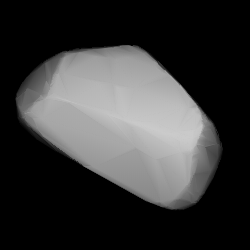 Modelled shape of Iva from its lightcurve | |
| Discovery | |
|---|---|
| Discovered by | Raymond Smith Dugan |
| Discovery site | Heidelberg |
| Discovery date | 4 November 1902 |
| Designations | |
| (497) Iva | |
| Pronunciation | /ˈaɪvə/[1] |
| 1902 KJ | |
| Orbital characteristics[2] | |
| Epoch 31 July 2016 (JD 2457600.5) | |
| Uncertainty parameter 0 | |
| Observation arc | 113.45 yr (41,438 d) 113.45 yr (41438 d) |
| Aphelion | 3.7065 AU (554.48 Gm) |
| Perihelion | 1.9966 AU (298.69 Gm) |
| 2.8516 AU (426.59 Gm) | |
| Eccentricity | 0.29981 |
| 4.82 yr (1,758.8 d) 4.82 yr (1758.8 d) | |
| 242.202° | |
| 0° 12m 16.848s / day | |
| Inclination | 4.8205° |
| 6.3305° | |
| 3.5819° | |
| Physical characteristics | |
| 4.620 h (0.1925 d) | |
| 10.02 | |
497 Iva is a main-belt asteroid orbiting the Sun, not to be confused with 1627 Ivar. It was discovered by American astronomer R. S. Dugan on 4 November 1902, and was named for Iva Shores, the young daughter of the family where he was staying in Heidelberg.[3] This object is orbiting at a distance of 2.85 AU with a period of 4.82 yr and an eccentricity of 0.3. The orbital plane is inclined at an angle of 4.8° to the plane of the ecliptic.[2]
This asteroid is classified as an M-type asteroid and is considered anhydrous[4] but oxidized.[5] Further analysis of the spectra suggests the "presence of either an olivine or high-Ca pyroxene phase in addition to orthopyroxene ± Type B clinopyroxene".[6] Analysis of light curves based on photometric data show a rotation period of 4.621±0.001 h with a brightness variation of 0.34±0.02 in magnitude.[7]
- ^ Noah Webster (1884) A Practical Dictionary of the English Language
- ^ a b Cite error: The named reference
jpldatawas invoked but never defined (see the help page). - ^ Cite error: The named reference
Schmadel2013was invoked but never defined (see the help page). - ^ Cite error: The named reference
Birlan_et_al_2007was invoked but never defined (see the help page). - ^ Cite error: The named reference
Busarev_Taran_2002was invoked but never defined (see the help page). - ^ Cite error: The named reference
Hardersen_et_al_2011was invoked but never defined (see the help page). - ^ Cite error: The named reference
Warner2009was invoked but never defined (see the help page).